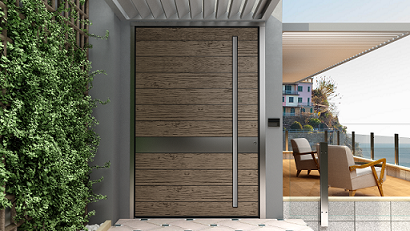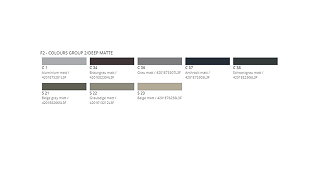Advice for choosing a door when installing in a Marine or Hostile Environmental situation
It is universally recognised that entrance doors installed in close proximity to the sea, an estuary, a swimming pool or certain industrial sites, will be constantly attacked by salt or other corrosive substances. It is important to follow our advice when choosing your front door, so that you enjoy years of trouble-free use and learn how to keep your door in pristine condition.
Which Door would be suitable in a marine environment?
We would recommend you specify our S-500 Series if you live in a hostile environment, because this door series is supplied with a full 5-year marine warranty. Within reason, you are free to choose from any of over 400 designs from this series. View the range of S-500 doors
Door Finishes and Colours
Our textured IGP finishes are the most resistant to attack. This luxurious textured finish is best suited to the following colours:
Which door handle is best in a marine environment?
There are options to consider here:
- Choose a recessed handle outside, so that there is no external furniture, except the brushed steel rosette that reinforces the area around the profile cylinder
- If you choose to order a rain deflector at the base of the door (recommended), always choose a polished finish
- Avoid furniture on the outside of the door, but if you want an external handle, it must be polished chrome
- Avoid fingerprint scanners and LED’s
- All S-500 series furniture is manufactured from AISI 316L. Steel Alloy 316L is austenitic stainless steel, with a high nickel and molybdenum content, which is more resistant with regard to pitting and crevice corrosion in chloride environments
Get in touch with Spitfire Doors
Best door lock for use in Marine environments
We recommend fitting a Spitfire electrically operated lock because it is more consistent in pulling the door slab tight-in against the frame, as the door closes.
Door frame
In hostile environments, we recommend a stronger and more stable outerframe than usual, choose from our AT100 or AT100P profiles.
Cill
We recommend a specifying a 150mm cill in marine environments to take water away from the door more quickly.
Maintenance
CLEANING STAINLESS STEEL – every week is recommended
Stainless steel is a metal alloy that contains at least 10.5 percent chromium. Although stainless steel is resistant to corrosion, it is not stain-proof. If salty water dries on a stainless steel surface, it usually leaves behind a white film. Remove salt spots from stainless steel by using cleaners that are effective yet safe for this surface. If you use harsh, abrasive products to clean stainless steel, you run the risk of making it susceptible to corrosion.
DO
- Use the mildest possible cleaning agents
- Use plastic or wood tools
- Follow any polishing lines if you use slightly abrasive cleaners
- Rinse thoroughly
- Wipe dry
DON’T
- Use steel or metal scrapers as they will cause rust spots
- Allow chemicals, bleaches or chlorides to remain on the steel for more than a minute
- Another method is as follows:
Things You'll Need - White vinegar - Baking soda – Soft cloths
Step 1 - Moisten a soft cloth with white vinegar
Step 2 - Dip the cloth into baking soda
Step 3 - Wipe off the salt spots with the cloth
Step 4 - Rinse the cloth under clean, running water, and use it to wipe off the area. This will remove any lingering residue from the baking soda
Step 5 - Dry the stainless steel surface with a lint-free cloth.
Other advice:
Cleaning the aluminium powder coated external surface of the door - every week is recommended
Powder coating is one of the most durable colour coatings and with very little effort on your part, it will provide you with many years of excellent service. To extend the life of your powder coated door and to comply with our warranty, a simple, regular maintenance program should be implemented.
The effects of ultra-violet light, atmospheric pollution, dirt, grime and airborne salt deposits can all accumulate over time and should be removed at regular intervals.
In beachfront homes, industrial or geothermal areas a cleaning program should be carried out weekly.
Simple steps to cleaning your powder coated Spitfire Door
- Carefully remove any loose surface deposits with a wet sponge
- Use a soft brush (non-abrasive) and a diluted solution of a mild detergent, eg, pH-neutral liquid hand dishwashing detergent in warm water to remove dust, salt and other deposits
- Ensure you thoroughly rinse the surfaces with clean fresh water after cleaning to remove all residues
- Stubborn marks on the powder coating may be removed with methylated spirits
- You can order special aluminium cleaner containing citrus in a 500ml can from Spitfire Doors, to spray on your door, which can be gently buffed to remove water marks and general dirt, like fingerprints.
To speak to a member of Spitfire Doors' customer service team, call 01625 412570, or email sales@spitfiredoors.co.uk


